【实战教程】用 Next.js 和 shadcn-ui 打造现代博客平台

你是否梦想过拥有一个独特、现代化的个人博客平台?今天,我们将一起动手,使用 Next.js 和 shadcn-ui 来创建一个功能丰富、外观精美的博客系统。无论你是刚接触 Web 开发,还是经验丰富的程序员,这个教程都将带你step by step地构建一个完整的博客平台,让你的文字创作之旅从此与众不同!
目录
- 1. 引言:为什么选择 Next.js 和 shadcn-ui 构建博客平台?
- 1.1 Next.js 在博客开发中的优势
- 1.2 shadcn-ui 简介及其特点
- 2. 项目设置和初始化
- 2.1 创建 Next.js 项目
- 2.2 集成 shadcn-ui
- 2.3 设置项目结构
- 3. 设计和实现博客的核心功能
- 3.1 创建博客首页
- 3.1.1 设计布局组件
- 3.1.2 实现文章列表展示
- 3.2 开发文章详情页
- 3.2.1 使用动态路由
- 3.2.2 实现 Markdown 渲染
- 3.3 添加评论功能
- 3.3.1 设计评论组件
- 3.3.2 实现评论提交和展示
- 4. 使用 Next.js API Routes 构建后端
- 4.1 创建文章 API
- 4.1.1 获取文章列表
- 4.1.2 获取单篇文章详情
- 4.2 实现评论 API
- 4.2.1 提交新评论
- 5. 集成数据库
- 5.1 选择和设置 MongoDB
- 5.2 创建数据模型
- 5.3 连接数据库并实现 CRUD 操作
- 6. 实现用户认证
- 6.1 设置 NextAuth.js
- 6.2 创建登录和注册页面
- 6.3 实现受保护的路由和操作
- 7. 优化用户界面和用户体验
- 7.1 响应式设计
- 7.2 添加加载状态和错误处理
- 7.3 实现无限滚动加载
- 8. 性能优化
- 8.1 实现静态生成(SSG)和增量静态再生(ISR)
- 8.2 图片优化
- 8.3 代码分割和懒加载
- 9. 部署博客平台
- 9.1 准备生产环境配置
- 9.2 选择合适的部署平台
- 9.3 部署过程和注意事项
- 10. 总结与下一步
- 10.1 回顾学到的核心概念
- 10.2 扩展功能的想法
- 10.3 持续学习的资源推荐
1. 引言:为什么选择 Next.js 和 shadcn-ui 构建博客平台?
在开始动手之前,让我们先了解为什么 Next.js 和 shadcn-ui 是构建现代博客平台的绝佳选择。

1.1 Next.js 在博客开发中的优势
Next.js 作为一个强大的 React 框架,为博客开发提供了许多优势:
- 服务器端渲染 (SSR): 提高首屏加载速度,对 SEO 友好。
- 静态站点生成 (SSG): 预渲染页面,提供极快的加载速度。
- 增量静态再生 (ISR): 在保持静态生成优势的同时,允许内容动态更新。
- API 路由: 轻松创建后端 API,无需单独的服务器。
- 图像优化: 自动优化图片,提升加载性能。
- 内置 CSS 支持: 简化样式管理,支持 CSS 模块和 Sass。
这些特性使 Next.js 成为构建高性能、SEO 友好的博客平台的理想选择。
1.2 shadcn-ui 简介及其特点
shadcn-ui 是一个现代化的 UI 组件库,它具有以下特点:
- 可定制性强: 组件设计灵活,易于根据需求进行定制。
- 无需安装: 直接复制组件代码到项目中使用。
- TypeScript 支持: 提供类型定义,增强开发体验。
- 暗黑模式: 内置暗黑模式支持,轻松实现主题切换。
- 无障碍设计: 组件符合 ARIA 标准,提高可访问性。
使用 shadcn-ui,我们可以快速构建出美观、功能丰富的用户界面,而无需从零开始设计每个组件。
2. 项目设置和初始化
让我们开始动手创建我们的博客平台!
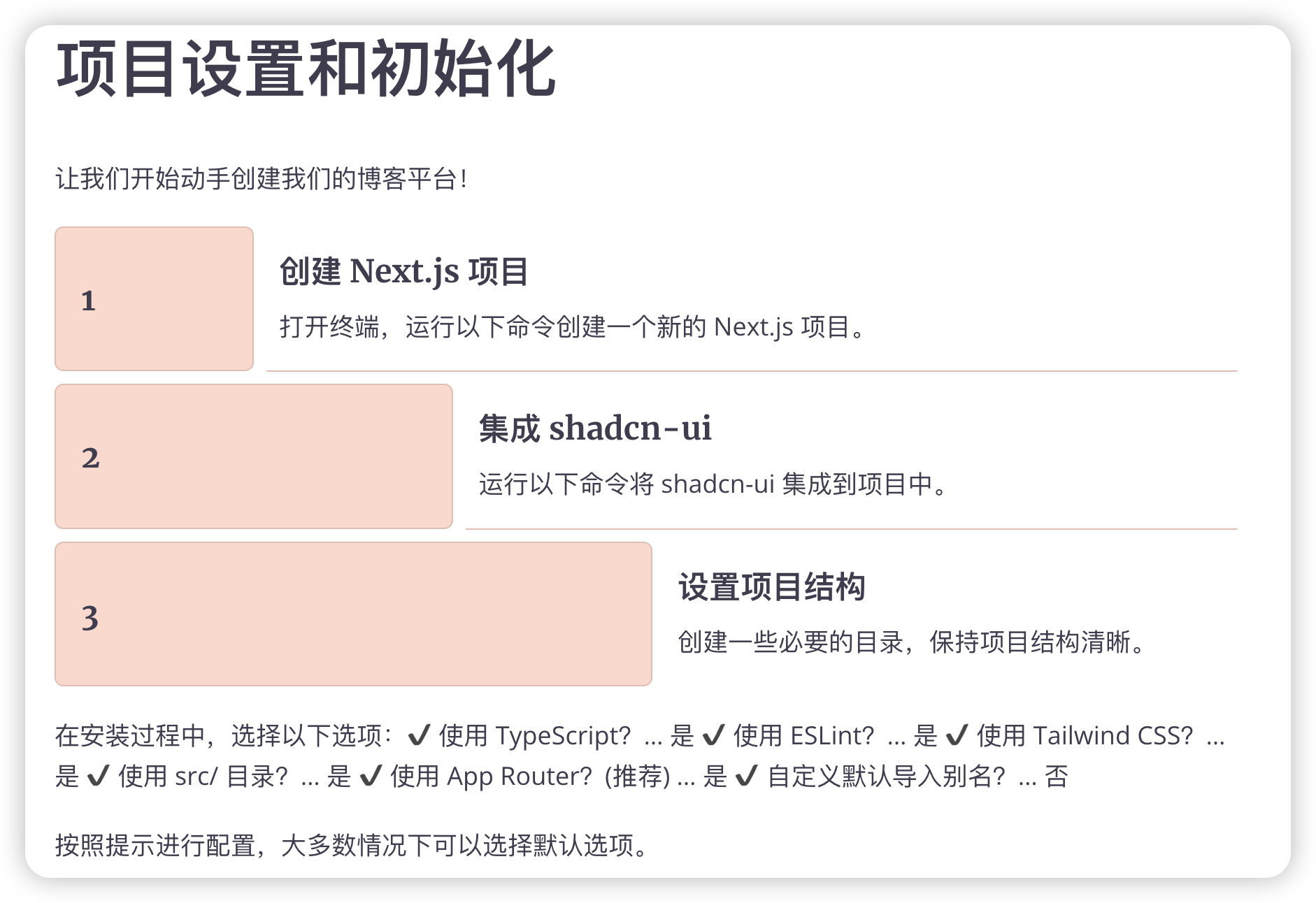
2.1 创建 Next.js 项目
首先,打开终端,运行以下命令创建一个新的 Next.js 项目:
npx create-next-app@latest my-blog-platform
cd my-blog-platform
在安装过程中,选择以下选项:
✔ Would you like to use TypeScript? … Yes
✔ Would you like to use ESLint? … Yes
✔ Would you like to use Tailwind CSS? … Yes
✔ Would you like to use `src/` directory? … Yes
✔ Would you like to use App Router? (recommended) … Yes
✔ Would you like to customize the default import alias? … No
2.2 集成 shadcn-ui
接下来,我们将集成 shadcn-ui 到我们的项目中。运行以下命令:
npx shadcn@latest init
按照提示进行配置,大多数情况下可以选择默认选项。
2.3 设置项目结构
为了保持项目结构清晰,让我们创建一些必要的目录:
mkdir -p src/{components,lib,styles,types}
现在我们的项目结构应该如下所示:
my-blog-platform/
├── src/
│ ├── app/
│ ├── components/
│ ├── lib/
│ ├── styles/
│ └── types/
├── public/
├── .eslintrc.json
├── next.config.js
├── package.json
└── tsconfig.json
3. 设计和实现博客的核心功能
现在我们已经搭建好了基本框架,让我们开始实现博客的核心功能。
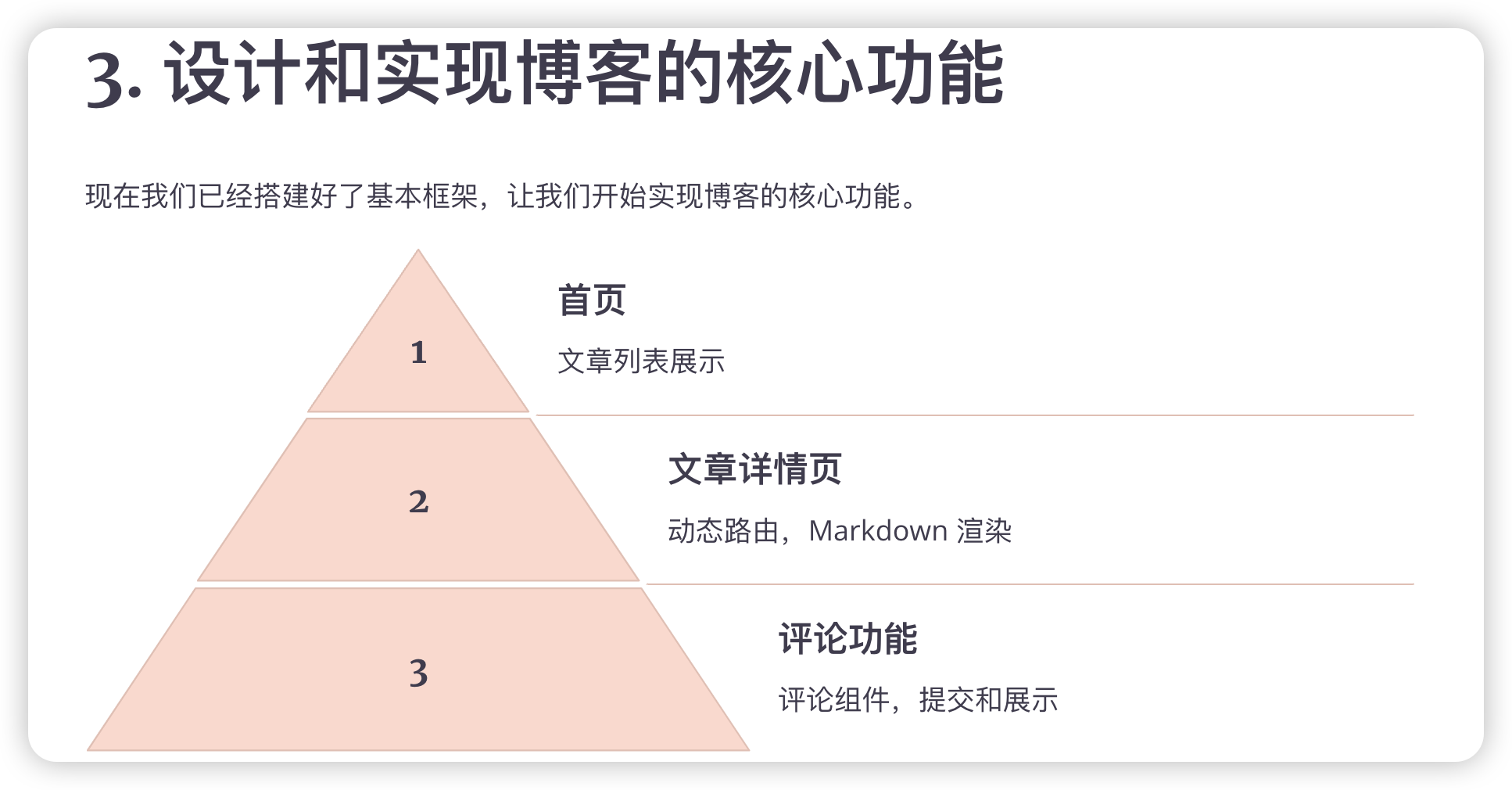
3.1 创建博客首页
3.1.1 设计布局组件
首先,我们需要创建一个基础布局组件。在 src/components 目录下创建 Layout.tsx 文件:
// src/components/Layout.tsx
import React from 'react'
import Link from 'next/link'
interface LayoutProps {
children: React.ReactNode
}
export default function Layout({ children }: LayoutProps) {
return (
<div className="min-h-screen bg-background font-sans antialiased">
<header className="border-b">
<nav className="container mx-auto px-4 py-6">
<Link href="/" className="text-2xl font-bold">
My Blog
</Link>
</nav>
</header>
<main className="container mx-auto px-4 py-8">{children}</main>
<footer className="border-t">
<div className="container mx-auto px-4 py-6 text-center">
© 2024 My Blog. All rights reserved.
</div>
</footer>
</div>
)
}
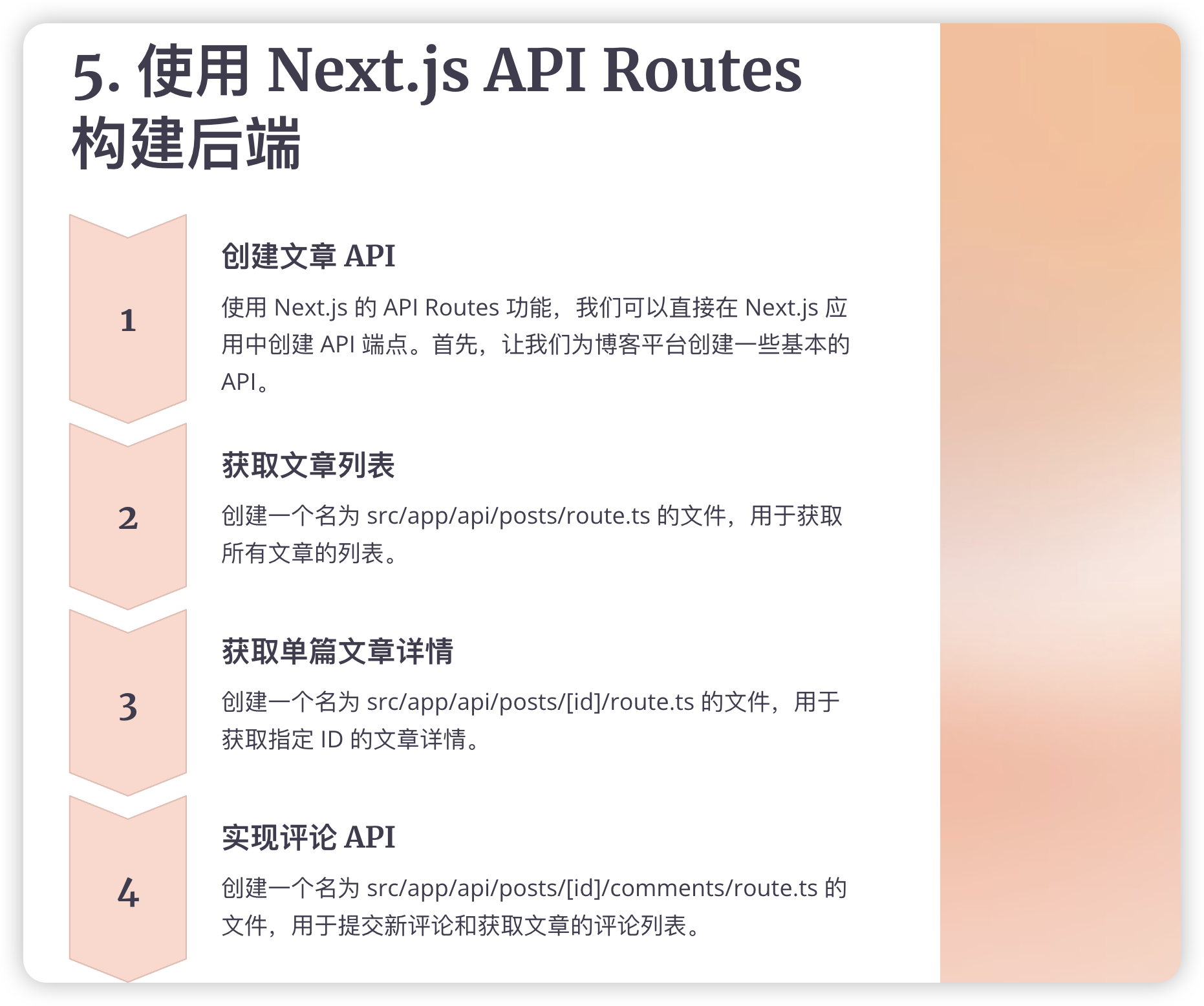
3.1.2 实现文章列表展示
接下来,我们将创建一个文章列表组件。新建 src/components/PostList.tsx 文件:
// src/components/PostList.tsx
import React from 'react'
import Link from 'next/link'
import { Card, CardContent, CardHeader, CardTitle } from './ui/card'
interface Post {
id: string
title: string
excerpt: string
}
interface PostListProps {
posts: Post[]
}
export default function PostList({ posts }: PostListProps) {
return (
<div className="grid gap-6 md:grid-cols-2 lg:grid-cols-3">
{posts.map((post) => (
<Card key={post.id}>
<CardHeader>
<CardTitle>
<Link href={`/post/${post.id}`} className="hover:underline">
{post.title}
</Link>
</CardTitle>
</CardHeader>
<CardContent>
<p className="text-muted-foreground">{post.excerpt}</p>
</CardContent>
</Card>
))}
</div>
)
}
增加依赖
npx shadcn@latest add card
现在,我们可以更新首页来使用这些组件。编辑 src/app/page.tsx:
// src/app/page.tsx
import Layout from '@/components/Layout'
import PostList from '@/components/PostList'
const dummyPosts = [
{ id: '1', title: 'First Post', excerpt: 'This is the first post' },
{ id: '2', title: 'Second Post', excerpt: 'This is the second post' },
{ id: '3', title: 'Third Post', excerpt: 'This is the third post' },
]
export default function Home() {
return (
<Layout>
<h1 className="text-3xl font-bold mb-6">Latest Posts</h1>
<PostList posts={dummyPosts} />
</Layout>
)
}
3.2 开发文章详情页
3.2.1 使用动态路由
Next.js 提供了强大的动态路由功能。让我们创建文章详情页。新建 src/app/post/[id]/page.tsx 文件:
// src/app/post/[id]/page.tsx
import Layout from '@/components/Layout'
interface PostPageProps {
params: { id: string }
}
export default function PostPage({ params }: PostPageProps) {
return (
<Layout>
<h1 className="text-3xl font-bold mb-6">Post {params.id}</h1>
<p>This is the content of post {params.id}</p>
</Layout>
)
}
3.2.2 实现 Markdown 渲染
大多数博客使用 Markdown 格式。让我们添加 Markdown 渲染功能。首先,安装必要的包:
npm install react-markdown
然后,创建一个 Markdown 渲染组件。新建 src/components/MarkdownRenderer.tsx 文件:
// src/components/MarkdownRenderer.tsx
import React from 'react'
import ReactMarkdown from 'react-markdown'
interface MarkdownRendererProps {
content: string
}
export default function MarkdownRenderer({ content }: MarkdownRendererProps) {
return <ReactMarkdown>{content}</ReactMarkdown>
}
更新文章详情页以使用 Markdown 渲染:
// src/app/post/[id]/page.tsx
import Layout from '@/components/Layout'
import MarkdownRenderer from '@/components/MarkdownRenderer'
interface PostPageProps {
params: { id: string }
}
const dummyPost = {
id: '1',
title: 'First Post',
content: '# Hello\n\nThis is the content of the first post.',
}
export default function PostPage({ params }: PostPageProps) {
return (
<Layout>
<h1 className="text-3xl font-bold mb-6">{dummyPost.title}</h1>
<MarkdownRenderer content={dummyPost.content} />
</Layout>
)
}
3.3 添加评论功能
3.3.1 设计评论组件
让我们创建一个评论组件。新建 src/components/Comments.tsx 文件:
// src/components/Comments.tsx
import React from 'react'
import { Card, CardContent, CardHeader, CardTitle } from './ui/card'
interface Comment {
id: string
author: string
content: string
createdAt: string
}
interface CommentsProps {
comments: Comment[]
}
export default function Comments({ comments }: CommentsProps) {
return (
<div className="mt-8">
<h2 className="text-2xl font-bold mb-4">Comments</h2>
{comments.map((comment) => (
<Card key={comment.id} className="mb-4">
<CardHeader>
<CardTitle>{comment.author}</CardTitle>
<p className="text-sm text-muted-foreground">
{new Date(comment.createdAt).toLocaleDateString()}
</p>
</CardHeader>
<CardContent>
<p>{comment.content}</p>
</CardContent>
</Card>
))}
</div>
)
}
3.3.2 实现评论提交和展示
现在,让我们在文章详情页中添加评论功能。更新 src/app/post/[id]/page.tsx:
// src/app/post/[id]/page.tsx
"use client"
import Layout from '@/components/Layout'
import MarkdownRenderer from '@/components/MarkdownRenderer'
import Comments from '@/components/Comments'
import { Button } from '@/components/ui/button'
import { Textarea } from '@/components/ui/textarea'
import { useState } from 'react'
interface PostPageProps {
params: { id: string }
}
const dummyPost = {
id: '1',
title: 'First Post',
content: '# Hello\n\nThis is the content of the first post.',
}
const dummyComments = [
{ id: '1', author: 'Alice', content: 'Great post!', createdAt: '2023-09-01T12:00:00Z' },
{ id: '2', author: 'Bob', content: 'Thanks for sharing.', createdAt: '2023-09-02T10:30:00Z' },
]
export default function PostPage({ params }: PostPageProps) {
const [comments, setComments] = useState(dummyComments)
const [newComment, setNewComment] = useState('')
const handleSubmitComment = (e: React.FormEvent) => {
e.preventDefault()
if (newComment.trim()) {
const comment = {
id: String(comments.length + 1),
author: 'Anonymous', // We'll update this when we add authentication
content: newComment.trim(),
createdAt: new Date().toISOString(),
}
setComments([...comments, comment])
setNewComment('')
}
}
return (
<Layout>
<h1 className="text-3xl font-bold mb-6">{dummyPost.title}</h1>
<MarkdownRenderer content={dummyPost.content} />
<Comments comments={comments} />
<form onSubmit={handleSubmitComment} className="mt-8">
<Textarea
value={newComment}
onChange={(e) => setNewComment(e.target.value)}
placeholder="Write a comment..."
className="mb-4"
/>
<Button type="submit">Submit Comment</Button>
</form>
</Layout>
)
}
这段代码添加了评论列表和评论提交表单。现在,用户可以查看现有评论并添加新评论。
4. 使用 Next.js API Routes 构建后端
Next.js 的 API Routes 功能允许我们直接在 Next.js 应用中创建 API 端点。让我们为我们的博客平台创建一些基本的 API。
4.1 创建文章 API
4.1.1 获取文章列表
创建 src/app/api/posts/route.ts 文件:
// src/app/api/posts/route.ts
import { NextResponse } from 'next/server'
const posts = [
{ id: '1', title: 'First Post', excerpt: 'This is the first post' },
{ id: '2', title: 'Second Post', excerpt: 'This is the second post' },
{ id: '3', title: 'Third Post', excerpt: 'This is the third post' },
]
export async function GET() {
return NextResponse.json(posts)
}
4.1.2 获取单篇文章详情
创建 src/app/api/posts/[id]/route.ts 文件:
// src/app/api/posts/[id]/route.ts
import { NextResponse } from 'next/server'
const posts = {
'1': { id: '1', title: 'First Post', content: '# Hello\n\nThis is the content of the first post.' },
'2': { id: '2', title: 'Second Post', content: '# Greetings\n\nThis is the content of the second post.' },
'3': { id: '3', title: 'Third Post', content: '# Welcome\n\nThis is the content of the third post.' },
}
export async function GET(request: Request, { params }: { params: { id: string } }) {
const post = posts[params.id]
if (post) {
return NextResponse.json(post)
} else {
return NextResponse.json({ error: 'Post not found' }, { status: 404 })
}
}
4.2 实现评论 API
4.2.1 提交新评论
创建 src/app/api/posts/[id]/comments/route.ts 文件:
// src/app/api/posts/[id]/comments/route.ts
import { NextResponse } from 'next/server'
let comments: { [key: string]: any[] } = {
'1': [
{ id: '1', author: 'Alice', content: 'Great post!', createdAt: '2023-09-01T12:00:00Z' },
{ id: '2', author: 'Bob', content: 'Thanks for sharing.', createdAt: '2023-09-02T10:30:00Z' },
],
}
export async function GET(request: Request, { params }: { params: { id: string } }) {
const postComments = comments[params.id] || []
return NextResponse.json(postComments)
}
export async function POST(request: Request, { params }: { params: { id: string } }) {
const { author, content } = await request.json()
const newComment = {
id: String(Date.now()),
author,
content,
createdAt: new Date().toISOString(),
}
if (!comments[params.id]) {
comments[params.id] = []
}
comments[params.id].push(newComment)
return NextResponse.json(newComment, { status: 201 })
}
现在我们有了基本的 API 端点,可以获取文章列表、单篇文章详情,以及提交和获取评论。
5. 集成数据库
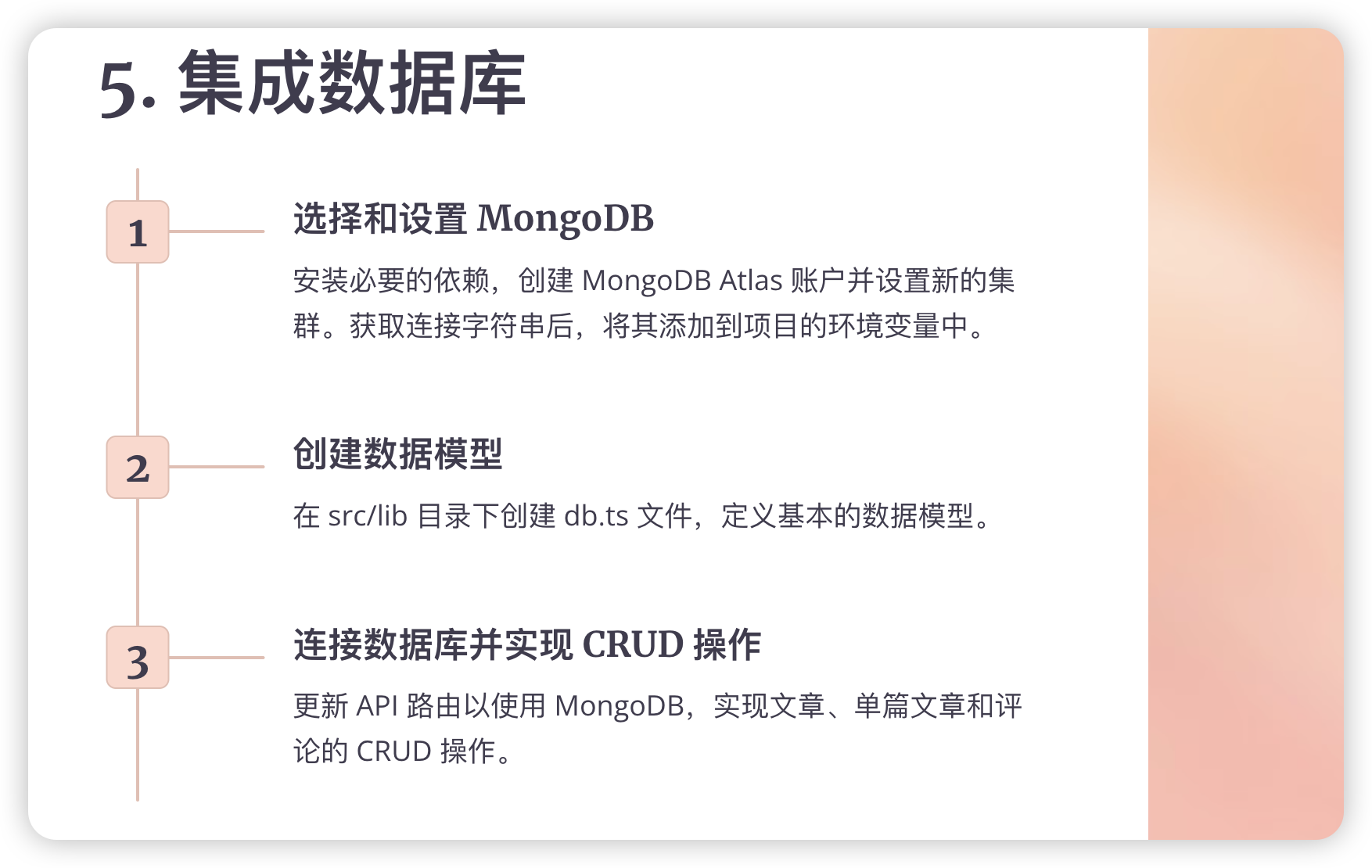
为了使我们的博客平台更加动态和可扩展,我们需要集成一个数据库。在这个例子中,我们将使用 MongoDB,因为它易于设置和使用。
5.1 选择和设置 MongoDB
首先,我们需要安装必要的依赖:
npm install mongodb
然后,创建一个 MongoDB Atlas 账户并设置一个新的集群。获取连接字符串后,将其添加到项目的环境变量中。创建一个 .env.local 文件:
MONGODB_URI=your_mongodb_connection_string_here
5.2 创建数据模型
让我们创建一些基本的数据模型。在 src/lib 目录下创建 db.ts 文件:
// src/lib/db.ts
import { MongoClient } from 'mongodb'
if (!process.env.MONGODB_URI) {
throw new Error('Invalid/Missing environment variable: "MONGODB_URI"')
}
const uri = process.env.MONGODB_URI
const options = {}
let client
let clientPromise: Promise<MongoClient>
if (process.env.NODE_ENV === 'development') {
// 在开发模式下,使用全局变量,以便在 HMR(热模块替换)导致的模块重新加载之间保留该值。
if (!(global as any)._mongoClientPromise) {
client = new MongoClient(uri, options)
;(global as any)._mongoClientPromise = client.connect()
}
clientPromise = (global as any)._mongoClientPromise
} else {
// In production mode, it's best to not use a global variable.
client = new MongoClient(uri, options)
clientPromise = client.connect()
}
export default clientPromise
5.3 连接数据库并实现 CRUD 操作
现在,让我们更新我们的 API 路由以使用 MongoDB。首先,更新文章 API:
// src/app/api/posts/route.ts
import { NextResponse } from 'next/server'
import clientPromise from '@/lib/db'
export async function GET() {
try {
const client = await clientPromise
const db = client.db('blog')
const posts = await db.collection('posts').find({}).toArray()
return NextResponse.json(posts)
} catch (e) {
console.error(e)
return NextResponse.json({ error: 'Failed to fetch posts' }, { status: 500 })
}
}
同样,更新单篇文章 API:
// src/app/api/posts/[id]/route.ts
import { NextResponse } from 'next/server'
import clientPromise from '@/lib/db'
import { ObjectId } from 'mongodb'
export async function GET(request: Request, { params }: { params: { id: string } }) {
try {
const client = await clientPromise
const db = client.db('blog')
const post = await db.collection('posts').findOne({ _id: new ObjectId(params.id) })
if (post) {
return NextResponse.json(post)
} else {
return NextResponse.json({ error: 'Post not found' }, { status: 404 })
}
} catch (e) {
console.error(e)
return NextResponse.json({ error: 'Failed to fetch post' }, { status: 500 })
}
}
最后,更新评论 API:
// src/app/api/posts/[id]/comments/route.ts
import { NextResponse } from 'next/server'
import clientPromise from '@/lib/db'
import { ObjectId } from 'mongodb'
export async function GET(request: Request, { params }: { params: { id: string } }) {
try {
const client = await clientPromise
const db = client.db('blog')
const comments = await db.collection('comments').find({ postId: new ObjectId(params.id) }).toArray()
return NextResponse.json(comments)
} catch (e) {
console.error(e)
return NextResponse.json({ error: 'Failed to fetch comments' }, { status: 500 })
}
}
export async function POST(request: Request, { params }: { params: { id: string } }) {
try {
const { author, content } = await request.json()
const client = await clientPromise
const db = client.db('blog')
const newComment = {
postId: new ObjectId(params.id),
author,
content,
createdAt: new Date().toISOString(),
}
const result = await db.collection('comments').insertOne(newComment)
return NextResponse.json({ ...newComment, _id: result.insertedId }, { status: 201 })
} catch (e) {
console.error(e)
return NextResponse.json({ error: 'Failed to add comment' }, { status: 500 })
}
}
这些更新将使我们的博客平台使用 MongoDB 数据库来存储和检索数据。
6. 实现用户认证
为了让用户能够发表评论和管理自己的文章,我们需要实现用户认证。我们将使用 NextAuth.js,它是一个灵活的认证解决方案,专为 Next.js 设计。
6.1 设置 NextAuth.js
首先,安装 NextAuth.js:
npm install next-auth
然后,创建一个 NextAuth.js 配置文件。在 src/app 目录下创建 api/auth/[...nextauth]/route.ts 文件:
// src/app/api/auth/[...nextauth]/route.ts
import NextAuth from "next-auth"
import GithubProvider from "next-auth/providers/github"
const handler = NextAuth({
providers: [
GithubProvider({
clientId: process.env.GITHUB_ID as string,
clientSecret: process.env.GITHUB_SECRET as string,
}),
],
})
export { handler as GET, handler as POST }
确保在 .env.local 文件中添加 GitHub OAuth 应用的凭证:
GITHUB_ID=your_github_client_id
GITHUB_SECRET=your_github_client_secret
NEXTAUTH_SECRET=your_nextauth_secret
6.2 创建登录和注册页面
创建一个简单的登录页面。在 src/app/login/page.tsx 中:
// src/app/login/page.tsx
'use client'
import { signIn } from 'next-auth/react'
import { Button } from '@/components/ui/button'
export default function LoginPage() {
return (
<div className="flex items-center justify-center min-h-screen">
<Button onClick={() => signIn('github')}>Sign in with GitHub</Button>
</div>
)
}
6.3 实现受保护的路由和操作
为了保护某些路由或操作,我们可以创建一个高阶组件。在 src/components 目录下创建 ProtectedRoute.tsx:
// src/components/ProtectedRoute.tsx
'use client'
import { useSession } from 'next-auth/react'
import { useRouter } from 'next/navigation'
import { useEffect } from 'react'
export default function ProtectedRoute({ children }: { children: React.ReactNode }) {
const { data: session, status } = useSession()
const router = useRouter()
useEffect(() => {
if (status === 'loading') return // Do nothing while loading
if (!session) router.push('/login')
}, [session, status])
if (status === 'loading') {
return <div>Loading...</div>
}
return session ? <>{children}</> : null
}
现在,你可以在需要用户登录的页面中使用这个组件。例如,在创建新文章的页面:
// src/app/new-post/page.tsx
import ProtectedRoute from '@/components/ProtectedRoute'
import NewPostForm from '@/components/NewPostForm'
export default function NewPostPage() {
return (
<ProtectedRoute>
<NewPostForm />
</ProtectedRoute>
)
}
这样,只有登录的用户才能访问创建新文章的页面。
7. 优化用户界面和用户体验
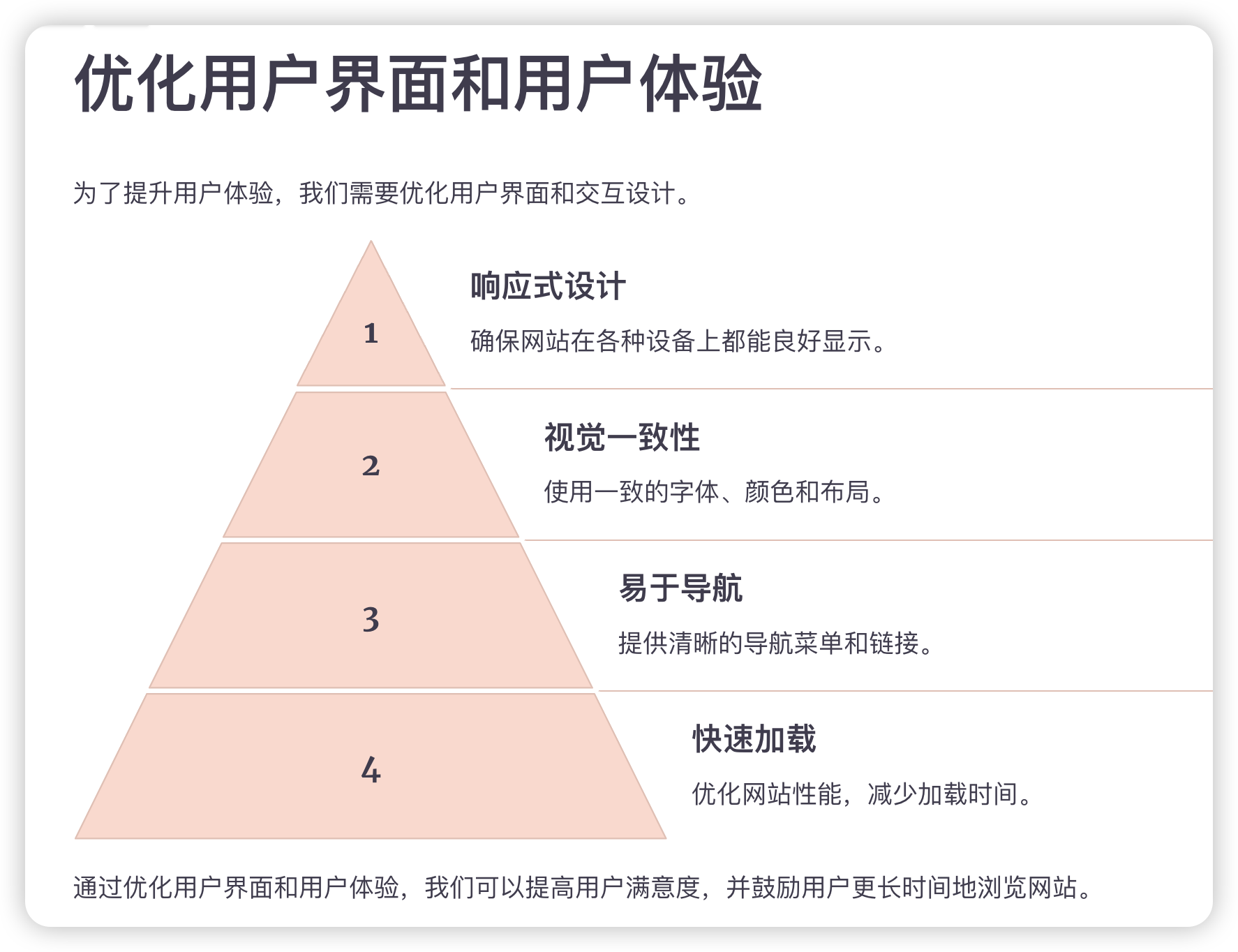
7.1 响应式设计
我们的博客平台已经使用了 Tailwind CSS,这使得创建响应式设计变得简单。确保在构建组件时使用 Tailwind 的响应式类,例如 md:, lg: 等。
7.2 添加加载状态和错误处理
为了提升用户体验,我们应该添加加载状态和错误处理。例如,在文章列表页面:
// src/app/page.tsx
'use client'
import { useState, useEffect } from 'react'
import Layout from '@/components/Layout'
import PostList from '@/components/PostList'
import { Spinner } from '@/components/ui/spinner'
import { Alert, AlertDescription, AlertTitle } from '@/components/ui/alert'
export default function Home() {
const [posts, setPosts] = useState([])
const [isLoading, setIsLoading] = useState(true)
const [error, setError] = useState(null)
useEffect(() => {
async function fetchPosts() {
try {
const response = await fetch('/api/posts')
if (!response.ok) {
throw new Error('Failed to fetch posts')
}
const data = await response.json()
setPosts(data)
} catch (err) {
setError(err.message)
} finally {
setIsLoading(false)
}
}
fetchPosts()
}, [])
return (
<Layout>
<h1 className="text-3xl font-bold mb-6">Latest Posts</h1>
{isLoading ? (
<div className="flex justify-center">
<Spinner size="lg" />
</div>
) : error ? (
<Alert variant="destructive">
<AlertTitle>Error</AlertTitle>
<AlertDescription>{error}</AlertDescription>
</Alert>
) : (
<PostList posts={posts} />
)}
</Layout>
)
}
7.3 实现无限滚动加载
为了提升大量文章的加载体验,我们可以实现无限滚动。首先,我们需要更新我们的 API 以支持分页:
// src/app/api/posts/route.ts
import { NextResponse } from 'next/server'
import clientPromise from '@/lib/db'
export async function GET(request: Request) {
const { searchParams } = new URL(request.url)
const page = parseInt(searchParams.get('page') || '1', 10)
const limit = parseInt(searchParams.get('limit') || '10', 10)
try {
const client = await clientPromise
const db = client.db('blog')
const posts = await db.collection('posts')
.find({})
.sort({ createdAt: -1 })
.skip((page - 1) * limit)
.limit(limit)
.toArray()
const total = await db.collection('posts').countDocuments()
return NextResponse.json({
posts,
currentPage: page,
totalPages: Math.ceil(total / limit)
})
} catch (e) {
console.error(e)
return NextResponse.json({ error: 'Failed to fetch posts' }, { status: 500 })
}
}
然后,我们可以在前端实现无限滚动。我们将使用 react-intersection-observer 库来检测滚动到底部的时机:
npm install react-intersection-observer
更新 src/app/page.tsx:
'use client'
import { useState, useEffect } from 'react'
import { useInView } from 'react-intersection-observer'
import Layout from '@/components/Layout'
import PostList from '@/components/PostList'
import { Spinner } from '@/components/ui/spinner'
import { Alert, AlertDescription, AlertTitle } from '@/components/ui/alert'
export default function Home() {
const [posts, setPosts] = useState([])
const [page, setPage] = useState(1)
const [isLoading, setIsLoading] = useState(true)
const [error, setError] = useState(null)
const [hasMore, setHasMore] = useState(true)
const { ref, inView } = useInView({
threshold: 0,
})
useEffect(() => {
if (inView && hasMore) {
loadMorePosts()
}
}, [inView, hasMore])
async function loadMorePosts() {
setIsLoading(true)
try {
const response = await fetch(`/api/posts?page=${page}&limit=10`)
if (!response.ok) {
throw new Error('Failed to fetch posts')
}
const data = await response.json()
setPosts((prevPosts) => [...prevPosts, ...data.posts])
setPage((prevPage) => prevPage + 1)
setHasMore(data.currentPage < data.totalPages)
} catch (err) {
setError(err.message)
} finally {
setIsLoading(false)
}
}
return (
<Layout>
<h1 className="text-3xl font-bold mb-6">Latest Posts</h1>
{posts.length > 0 && <PostList posts={posts} />}
{error && (
<Alert variant="destructive">
<AlertTitle>Error</AlertTitle>
<AlertDescription>{error}</AlertDescription>
</Alert>
)}
{isLoading && (
<div className="flex justify-center mt-4">
<Spinner size="lg" />
</div>
)}
<div ref={ref} style={{ height: '10px' }} />
</Layout>
)
}
8. 性能优化
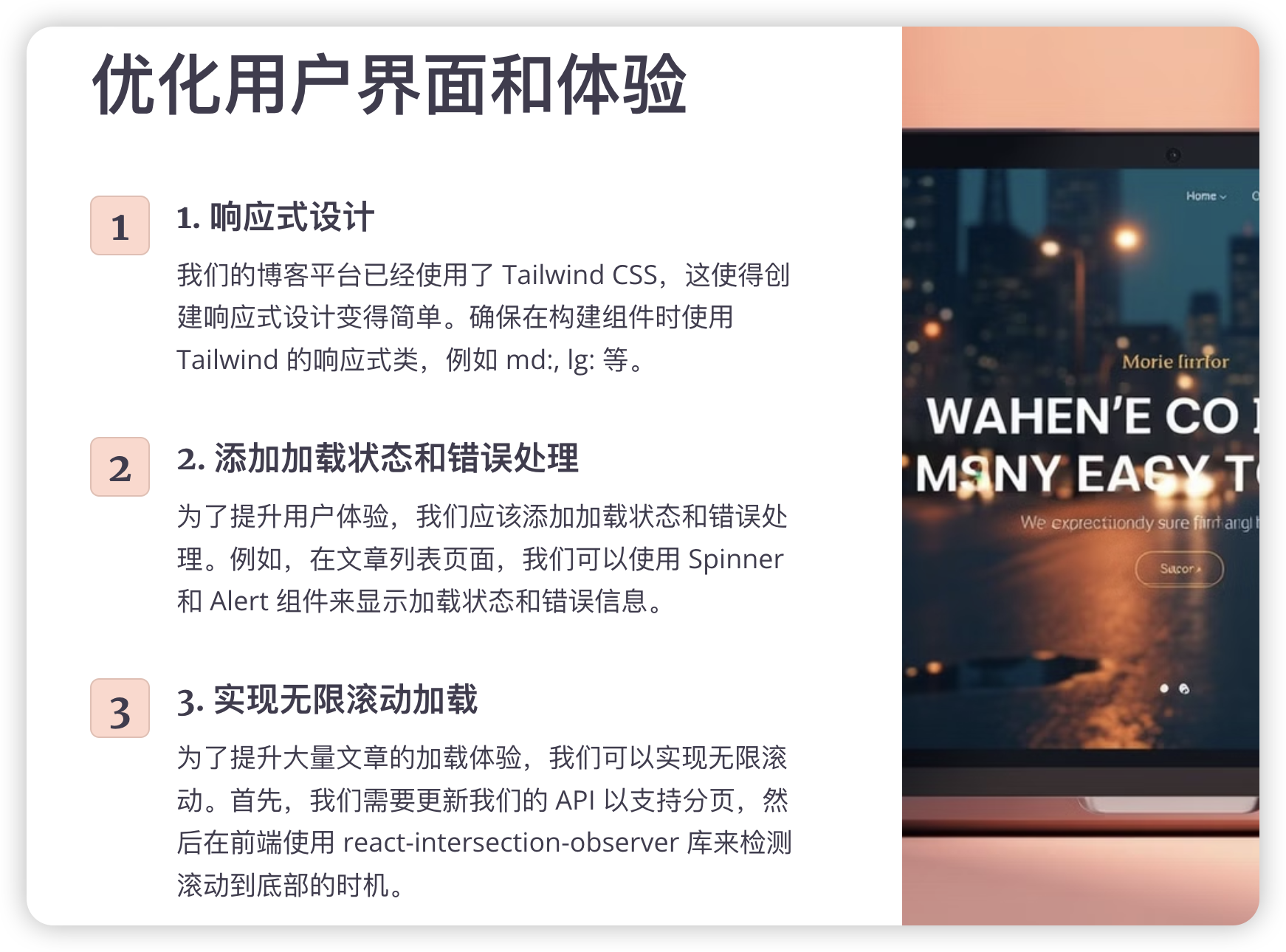
8.1 实现静态生成(SSG)和增量静态再生(ISR)
Next.js 提供了强大的静态生成和增量静态再生功能。对于博客文章这种不经常更新的内容,我们可以使用这些功能来提高性能。
更新 src/app/post/[id]/page.tsx:
import { Suspense } from 'react'
import { notFound } from 'next/navigation'
import Layout from '@/components/Layout'
import MarkdownRenderer from '@/components/MarkdownRenderer'
import Comments from '@/components/Comments'
import clientPromise from '@/lib/db'
import { ObjectId } from 'mongodb'
async function getPost(id: string) {
const client = await clientPromise
const db = client.db('blog')
const post = await db.collection('posts').findOne({ _id: new ObjectId(id) })
if (!post) {
notFound()
}
return post
}
export async function generateStaticParams() {
const client = await clientPromise
const db = client.db('blog')
const posts = await db.collection('posts').find({}, { projection: { _id: 1 } }).toArray()
return posts.map((post) => ({
id: post._id.toString(),
}))
}
export default async function PostPage({ params }: { params: { id: string } }) {
const post = await getPost(params.id)
return (
<Layout>
<h1 className="text-3xl font-bold mb-6">{post.title}</h1>
<MarkdownRenderer content={post.content} />
<Suspense fallback={<div>Loading comments...</div>}>
<Comments postId={params.id} />
</Suspense>
</Layout>
)
}
export const revalidate = 3600 // Revalidate every hour
8.2 图片优化
Next.js 提供了内置的图像优化组件。确保在整个应用中使用 next/image 组件:
import Image from 'next/image'
// In your component
<Image src="/path/to/image.jpg" alt="Description" width={500} height={300} />
8.3 代码分割和懒加载
Next.js 默认进行代码分割,但我们可以通过动态导入进一步优化:
import dynamic from 'next/dynamic'
const DynamicComponent = dynamic(() => import('@/components/HeavyComponent'), {
loading: () => <p>Loading...</p>,
})
9. 部署博客平台

9.1 准备生产环境配置
确保所有环境变量都已正确设置。创建一个 .env.production 文件来存储生产环境特定的变量。
9.2 选择合适的部署平台
对于 Next.js 应用,Vercel 是一个很好的选择,因为它是由 Next.js 的创建者开发的。
9.3 部署过程和注意事项
- 将你的代码推送到 GitHub 仓库。
- 在 Vercel 上创建一个新项目,并连接到你的 GitHub 仓库。
- 配置你的环境变量。
- 部署你的应用。
确保在部署之前运行构建命令并修复任何警告或错误:
npm run build
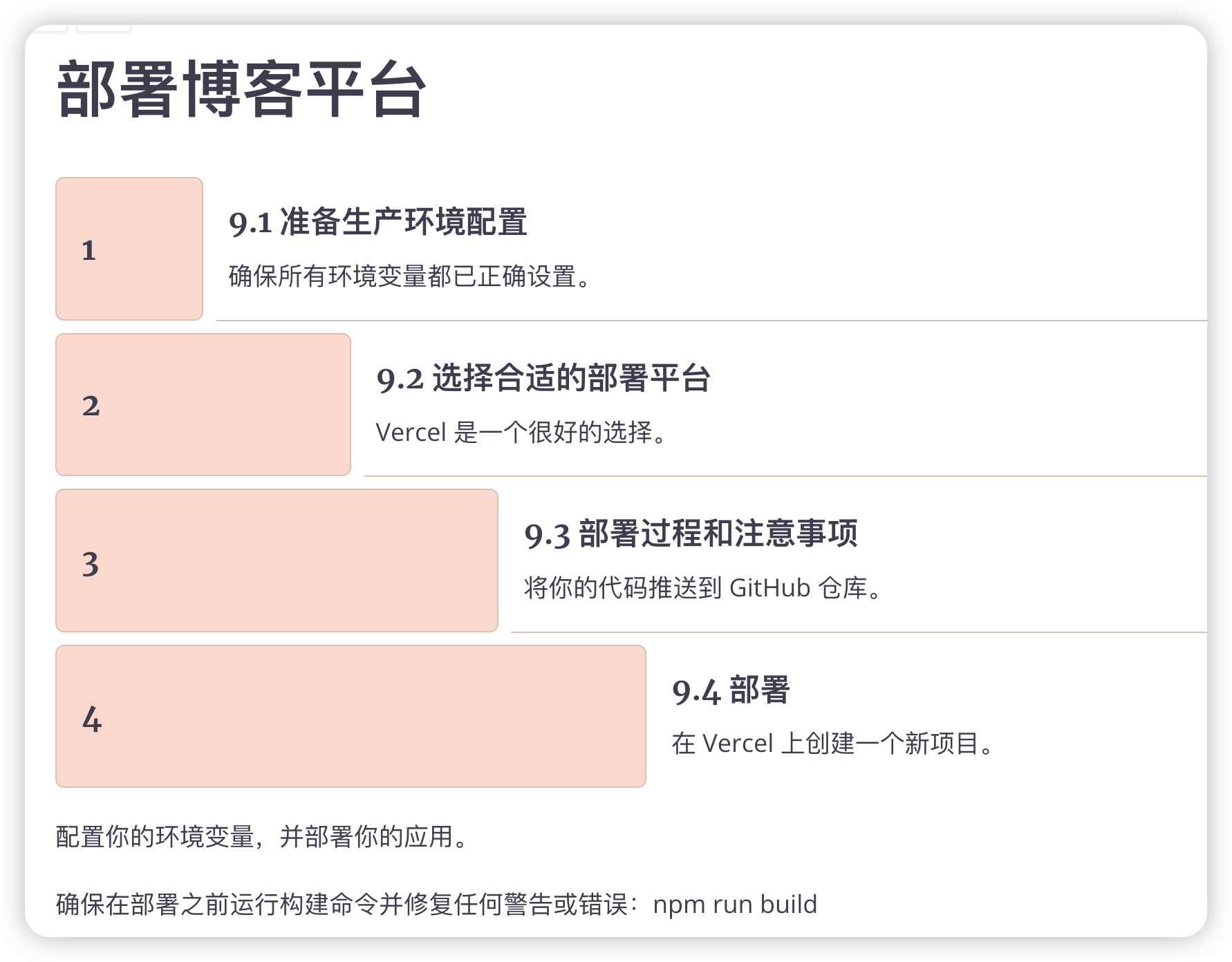
10. 总结与下一步
10.1 回顾学到的核心概念
在这个项目中,我们学习了:
- 使用 Next.js 创建全栈应用
- 集成 shadcn-ui 构建美观的用户界面
- 实现服务器端渲染和 API 路由
- 使用 MongoDB 进行数据持久化
- 实现用户认证和授权
- 优化应用性能和用户体验
10.2 扩展功能的想法
- 实现文章搜索功能
- 添加标签和分类系统
- 集成富文本编辑器
- 实现用户个人资料页面
- 添加社交分享功能
10.3 持续学习的资源推荐
- Next.js 官方文档
- React 官方文档
- MongoDB 大学
- Vercel 部署文档
通过这个项目,你已经掌握了使用 Next.js 和 shadcn-ui 构建现代博客平台的核心技能。继续探索和实践,你将能够构建更加复杂和功能丰富的 Web 应用。记住,学习是一个持续的过程,保持好奇心和实践精神,你将在 Web 开发领域取得更大的进步!
